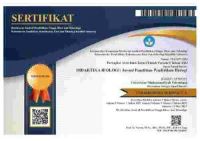PENGEMBANGAN SOAL BERBASIS HIGHER ORDER THINKING SKILL (HOTS) SERTA IMPLEMENTASINYA DI SMA NEGERI 8 PALEMBANG
Abstract
Tujuan penelitian ini adalah untuk menghasilkan soal berbasis HOTS lengkap dengan panduan penyusunan soalnya. Metode penelitian ini terdiri dari (1) defining the test universe, audience and puprose; (2) developing a test plan; (3) composing the test items; (4) writting the administration instruction; (5) conduct the piloting test; (6) conduct the item analysis; (7) revise the test; (8) validation of test; (9) developing the norms; (10) completting the test manual. Hasil penelitian yang diperoleh 1) keseluruhan item fit dengan nilai reliabilitas pada kategori sangat bagus (0,93), akan tetapi item 1 dan item 20 terjangkit DIF yang lebih berpihak terhadap kelompok IPS sehingga keputusan final item tersebut perlu dihapuskan. 2) Secara keseluruhan instrumen riset pada penelitian ini menunjukkan bahwa ia mengukur apa yang seharusnya diukur karena telah memenuhi persyaratan unidimensionalitas sebesar 20%. 3) Manual test yang disusun berada pada kriteria sangat layak (A). 4) Pada tingkat responden terlihat bahwa 133 siswa memiliki HOTS tinggi sedangkan 64 siswa memiliki HOTS rendah dan 24 responden berada pada kriteria misfit yang didalamnya terdapat responden dengan HOTS tinggi. Hal ini mengindikasikan masih banyak siswa yang memiliki kemampuan HOT rendah. Estimasi ini didukung dengan hasil reliabilitas person yang menunjukkan kemampuan HOT person berada pada kriteria cukup (0,72).
The study aimed to generate the HOTS-based problem with its guidance on preparing the test. Research methods consisted of (1) defining the test universe, audience and puprose; (2) developing a test plan; (3) composing the test items; (4) writting the administration instruction; (5) conduct the piloting test; (6) conduct the item analysis; (7) revise the test; (8) validation of test; (9) developing the norms; (10) completting the test manual. The results obtained 1) the overall fit item with the reliability value were in very good category (0.93), but item 1 and item 20 infected by DIF were more favorable to the IPS group so the final decision of the item needs to be abolished. 2) Overall the research instrument in this study showed that it measures what should be measured because it has met the unidimensionality requirement of 20%. 3) Manual test that arranged was in very feasible (A). 4) At the level of respondents showed that 133 students have high HOTS while 64 students have low HOTS and 24 respondents are on misfit criteria in which there are respondents with high HOTS. This indicated that there are still many students who have low HOT ability. This estimation was supported by the results of the person reliability that shows the HOT person ability was in enough criteria (0.72).
Keywords
Full Text:
PDFReferences
Arifin, Z. (2013). Evaluasi Pembelajaran. Bandung: Remaja Rosdakarya.
Bond, T.G. & Fox, C.M. (2007). Applying The Rasch Model: Fundamental Measurement in the Human Sciences (2nd ed). London: Lawrence Erlbaum Associates, Publishers.
Borich, G.D. (1994). Observation Skill for Effective Teaching (2nd ed). New York: McMillan Publishing Company.
Brookhart, S.M. (2010). How to Assess Higher Order Thinking Skill in Your Classroom. Alexandria: ASCD Publisher.
Dewi, N.D.L. (2015). Pengembangan Instrumen Penilaian IPA untuk Memetakan Critical Thinking dan Practical Skill Peserta Didik SMP. Tesis, tidak dipublikasikan. Universitas Negeri Yogyakarta.
Duhita, R. (2015). Analisis Butir Soal Ujian Akhir Semester Gasal Mata Pelajaran Pengantar Akuntansi Kelas X Akuntansi SMK Negeri 1 Godean Tahun Ajaran 2014/2015. Skripsi. Universitas Negeri Yogyakarta.
Mardapi, D. (2008). Teknik Penyusunan Instrumen Tes dan Nontes. Yogyakarta: Mitra Cendikia Press.
McIntire, S.A. dan Miller, L.A. (2007). Foundation of Psychological Testing A Practical Approach. California: Sage Production.
Misbach, I.H. & Sumintono, B. (2014). Pengembangan dan Validasi Instrumen Persepsi Siswa tehadap Karakter Moral Guru di Indonesia dengan Model Rasch. Makalah diseminarkan pada Seminar Nasional Psikometri, Universitas Muhammadiyah Surakarta.
Safar, J.H. & Embong. (2015). The Construction Of Peer-Based Behavioural Assesment Instrument For Secondary School Students. Jurnal Persatuan Saintis Muslim Sriwijaya, 5 (2), 46-61.
Sarnapi. (2016). Peringkat Pendidikan Indonesia Masih Rendah. Diakses dari http://www.pikiranrakyat.com/pendidikan/2016/06/18/peringkatpendidikan-indonesia-masih-rendah372187 pada 18 Juni 2016.
Sofiana, S. (2010). Analisis Butir Soal Ulangan Kenaikan Kelas Mata Pelajaran Kimia Kelas X SMA Negeri 8 Surakarta Tahun Ajaran 2009/2010. Skripsi. Universitas Negeri Sebelas Maret.
Sumintono, B. & Widhiarso, W. (2013). Aplikasi Model Rasch untuk Penelitian Ilmu-ilmu Sosial. Cimahi: TrimKom Publishing House.
Sumintono, B. & Widhiarso, W. (2015). Aplikasi Pemodelan Rasch pada Assessment Pendidikan. Cimahi: TrimKom Publishing House.
DOI: https://doi.org/10.32502/dikbio.v2i1.1648
Copyright (c) 2019 Didaktika Biologi: Jurnal Penelitian Pendidikan Biologi
Didaktika Biologi: Jurnal Penelitian Pendidikan Biologi is indexed by:

Didaktika Biologi: Jurnal Penelitian Pendidikan Biologi is licensed under a Creative Commons Attribution-ShareAlike 4.0 International License.







